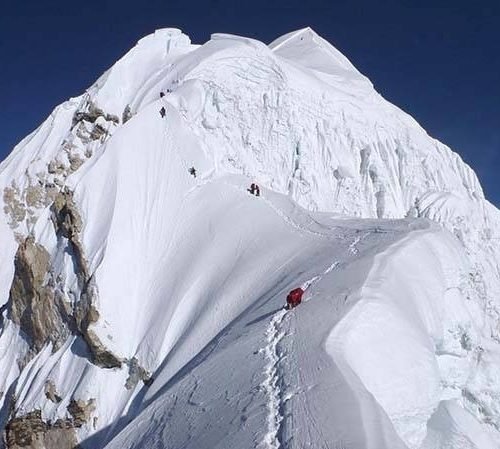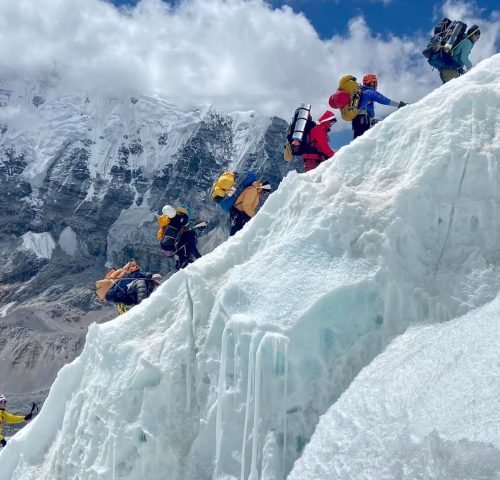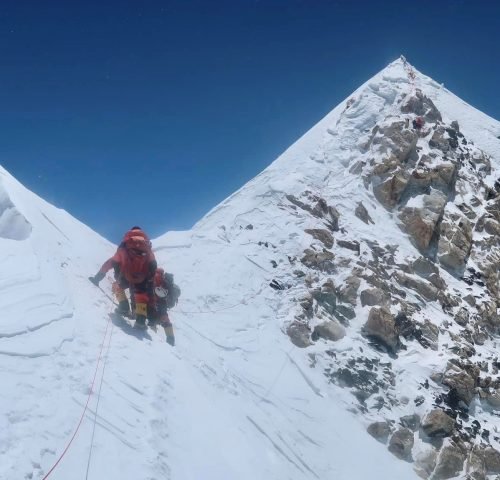Overview
Everest base camp trek is the most famous trekking destination because of the world’s highest mountain and Buddhist culture in the captivating valley of Khumbu. The trek cost and itinerary are customized according to your vacation and group size. The Mount Everest base camp trek route is one of the most popular destinations of the Himalayas which meets the highest mountain in the world. It is including Mount Everest (8848.86m) and the world heritage site Sagarmatha National Park as well. Early in morning climb of Kalapattar (5,545m /18187ft), you will enjoy with the breathtaking panoramic view of mount Everest surrounded by adjoining mountains, it is the highlight of the Everest base camp trek.
Sherpa’s culture also the main attraction of Everest basecamp trek. Himalayan exoedition & treks provide wonderful service and cost and guide you to amazing pictures of the high Khumbu valley. While the valley of inhabitant Sherpa tribe’s friendly people offers warm hospitality in the comfort of nice and cozy lodges on the route of the Everest Base Camp trek. The Everest Base Camp trek of 14 days begins from Lukla (2,860m/9380ft) after 35 mins thrilling airstrip from Kathmandu. The airport at present is named after Everest’s legendary heroes Tenzing & Hillary the first to conquer Everest on May 29th, 1953 AD. After getting organized with the Himalayan Smile Treks, our porters will then carry your baggage full of responsibility. Sometimes laden on Jhopkyo(mix breed of Yak and normal cow) will carry them as Yak cannot survive below the 3,000m/9840ft. So the crossbred animals are used for carrying loads of trekkers and mountaineering expeditions. Follow our expert local base camp guide who will show you the wonders of Everest.
The Everest base camp trek route leads towards the Khumbu high valley as the altitude picks up following the Dudh Kosi and Imja Tse rivers. Both river origin is the glaciers of Khumbu. The walk is pleasant although a touch of the high altitude above 4,500 m /14760ft. Thyangboche Monastery with its a famous old monastery steeped in over 500 years of history including awesome mountain scenery. As the elevation gains trek leads toward the high Khumbu valley past the nice areas of Pangboche and Dingboche. Then reach a high mountainous area and glaciers as the walking approach at Everest base camp at 5364 m beneath the South face of Mt. Everest. Finally, the views of amazing Khumbu icefalls and glaciers will leave you delighted on the Everest base camp trek. After a grand moment reaching the Everest base camp, the next adventure leads to the highest spot at Kalapattar top (5,545m/18187ft). The hill is a notable landmark located on the south ridge of Pumori in the Nepalese Himalayas. From Gorakshep, it takes you 2.5 hours to climb to the Kala Patthar. The marvelous and panoramic mountain view from Kala Pattar including Mount Everest (8848 m) and more :
• Mt Everest (8,848.86m/29, 028ft)
• Lhotse (8,516 m/24,940 ft) • Nuptse (7,900m/25,772 ft)
• Makalu (8,463m/27758ft)
• Pumori (7,161m/23488ft)
• Tharmarsarku (6,623m/21723ft)
• Mt. Amadablam (6,814m/22349.08ft)
• And many more…
Details Itinerary
Day 01: Arrival in Kathmandu 1300m and transfer to Hotel.
Our office representatives will welcome you outside the terminal hall and transfer you to the hotel. brief you about tomorrow’s activities and collect any documents required by our office.
Day 02: Expedition Preparation.
On the second day, we will complete all of our formalities, such as getting the required paperwork, permits, and other formalities required for our expedition, and we will begin making preparations for it. We will now prepare our luggage, go shopping, and double-check everything we need (especially medicines and essentials). There will be briefings on every part of the expedition, including all gear and equipment, the length of the trip, lodging options, base camp facilities, and all other aspects related to the expedition. It also gives you the chance to interact with and get to know your climbing companions and colleagues.
Day 03: Fly to Lukla 2800m and trek to Phakding 2600m. ( 3 hours trek)
We take an early morning flight to Lukla, where all Everest treks begin. You will need permission from the locals to continue exploring once you arrive in Lukla. This is the entrance to the protected Khumbu Region. To proceed, you will need the Khumbu Pasang Lhamu Entry Permit. The Trekkers Information Management System card has been replaced with this admission permission. The admission fee goes toward the development of the rural community.
Once you get into Lukla, eat breakfast at the lodge, and prepare luggage for the porters, the walking starts. To get to Phakding, there are a few ups and downs, as well as many prayer rocks (Mani in the local language). After you’ve settled into your Phakding lodge, take a short walk to the village.
Day 04: Trek to Namche Bazar 3340m. (6 hours trek)
Our trail passes through a pine forest, and we continue our walk on the trail that goes north up the Benkar valley. We cross the Dudh Koshi River and pass Chumoa and Monjo villages before reaching the entrance of the Everest National Park. Then, after crossing a suspension bridge, we pass Jorsale village and walk alongside the Dudh Koshi and Bhote Koshi rivers. ascend on a steep trail and reach Namche Bazaar, which is probably the biggest town in the Everest region.
Day 05: Acclimatization day in Namche.
We can tour Namche Bazaar, which is the primary town of the Everest or Khumbu region. We can hike up to the Everest viewpoint hotel and enjoy the sunrise over the Himalayas, including Mt. Everest, Lhotse, Nuptse, Ama Dablam, Thamserku, Kongde, and so on. If we are interested in a day hike, we can trek to Khumjung village. Today we also visit the Hillary School and a monastery that houses a yeti’s scalp.
Day 06 : Trek to Tyangboche (3,870M, 5-6 HRS)
The trail climbs up from the town and then contours around the hillside, offering great views including Everest and Khumjung. Look out for spotted deer, Himalayan tahrs and birds – including the colorful (male) Danphe pheasant (Nepal’s national bird). The trail rises to Sanasa where the routes to Gokyo and Everest BC fork. The trail to the right then descends to cross the Dudh Koshi (past water driven prayer wheels) on a suspension bridge near Phunki Thenga (3,250m), the lowest point north of Namche Bazaar. It then enters the Imja Khola Valley and rises steeply, through dwarf conifers and rhododendron forest, for a two hour pull, to the hilltop village of Tengboche. Their famous Gompa is set against the backdrop of Ama Dablam, Nuptse, Everest, Kangtega and other peaks. At full moon in October/November they hold the colourful Mani Rimdu festival which includes masked dancing and Tibetan Opera in the monastery courtyard. Visit the monastery during the afternoon.
Day 07: Trek to Dingboche (4,360 M, 5-6 HRS)
Today’s trail descends to Debuche: a scattered stone village with a nunnery, chortens and long mani wall. Cross the suspension bridge over the Imja Khola and gradually ascend to Pangboche with views of towering Ama Dablam (6,856m) perhaps the most beautiful mountain in the Everest region). The trail then follows the river fairly closely as it gradually rises to its confluence with the Lobuche Khola and continues up to Dingboche: the last year-round Sherpa settlement in the region. Different views of Ama Dablam rise above the terraced fields of barley, buckwheat and potatoes. The fields are walled to protect crops from icy winds and animals during the short growing season.
Day 08: Second acclimatazation in Dingboche.
This is another scheduled rest day on the trek and will assist your fitness and oxygen intake at the higher altitudes to follow. An enjoyable 3-4 hrs side walk, 400m climb to Nangkartshang Gompa, on the ridge north of Dingboche village can be the best choice. This vintage point offers Mt. Makalu (8,463m) fifth highest Mountain in the world then trek to Dingboche for the night.
Day 09: Trek to Lobuche (4,940M, 4-5 HRS)
On this beautiful day start after breakfast . The trail climbs to a ridge providing towering views of Taboche Peak and Cholatse and continues through Yak pastures before crossing a wooden bridge over a roaring stream to Duglha (4,620m). The trail then ascends steeply for an hour, up the gravely terminal moraine of the Khumbu Glacier. On the summit is a large group of stone-pile memorials to lost Sherpas and climbers. It also affords great border-views including Khumbutse, Lingtren, and Pumori. Everest is hidden behind the towering wall of Nuptse and Lhotse. Follow the valley upstream for about an hour to Lobuche.
Day 10: trek to Goeakshep(5,160 M) - Everest base camp (5,364 M) back to Gorakshep (7-8 HRS)
A long rewarding day, follow the windblown and rocky path along the barren moraine of the Khumbu Glacier to the last village at Gorak Shep. After an early lunch, set out on the feint trail to the world’s highest Base Camp, on the Khumbu Glacier: opposite the dreaded icefall – the most dangerous section of an Everest ascent. Trek back to Gorak Shep for the night at Lodge.
Day 11: Climb Kalapatther (5,545M) - Pheriche (4,280M, 7-8 HRS)
On this day early morning climb of 2-3 hours up Kala Patthar, behind the village, offers a sunrise awakening of the Himalayan chain. Drop back to Gorakshep for breakfast, and then retrace your steps down to Lobuche. Return to the snout of the Khumbu glacier, dropping down the moraine and continuing on to the village of Pheriche for a lower and warmer night.
Day 12: Trek back to Namche (3,44M, 6-7 HRS)
Today’s trail gradually descends to Deboche before a mild rise through rhododendron forest to the hilltop village of Tengboche which has an important monastery and great views in all directions. A long descent, leads to Phunki Thenga (3,250m) on the Imja Khola: the trek’s lowest point north of Lukla then pleasant contour walk back to Namche Bazaar.
Day 13: Namche - Lukla (2,642M, 6-7 HRS)
From Namche, the trail descends to more comfortable altitudes, passing through the friendly farming villages of Jorsale (where we exit the National Park), Monjo, Phakding, then crosses the suspension bridge at Thado Koshi before rising to Ghat and Cheplung.
Day 14: Fly lukla to kathmandu.
Early in the morning you will fly back to Kathmandu and transfer to hotel/ relaxing or you can explore some heritage side in Kathmandu
Day 15: Final departure.
Our reprasantative will drop you at international airpot.
Cost Details
Cost Exclude:
• Airport arrival and departure by private vehicle.
• 3 star accommodation in Kathmandu for two nights with breakfast
• Kathmandu-lukla-Kathmandu flights
• Trek leader (English speaking, First Aid and eco trained), Sherpa helper, and all payments
• Sagarmatha National park entry fee and necessary permits
• Full board meal (breakfast, lunch & dinner in during the trek
• Comfortable accommodation on teahouse/lodge during the trek
• Everest base camp trek permit & Local grassland permits.
• First aid medical kit bag
• All government and local taxes.
Cost Does not exclude:
• Lunch and dinner in kathmandu
• Travel and rescue insurance
• Personal trekking Equipments
• Personal expenses e.g:Tea,Coffee,phone calls, laundry, hot shower, bettery re-charge,bar bills & extra porters
• Tips for guides and porters
• Any extending trips
Map
FAQs
1. How high is Everest Base Camp ?
Everest base camp is situated at the altitude of 5345m from sea-level
2. How fit do I need to go trekking to Annapurna Base camp ?
The travellers who are physically and mentally fit can do Everest base camp trek.
3. Where am I sleeping at night ?
Nowadays there are many hotels and lodges, we can overnight at guest houses/hotels.
4. Which is the best season to Trekking in Annapurna Base camp ?
Autumn and spring is The best season for Everest base camp trek.
5. Is drinking water easily available during the trek ? Is it safe ?
Yes, drinking water is readily available during the Everest Base Camp trek. Throughout the trekking route, you will find multiple sources to obtain safe drinking water. Here's a more detailed explanation of the availability of drinking water during the Everest Base Camp trek.
6. How do we Travel from Kathmandu to Namche ?
We have three option to travel Namche Bazar.
- Traveling via flight Flight duration: 30 minutes + trekking for 2 days of Most tourists take a short 30-minute flight from Kathmandu to Lukla airport/ the Tenzing-Hillary Airport. ...
- Traveling by road Duration: 1 week If you wish to travel to Namche Bazaar via a private vehicle it might take around 7 days for you to reach your destination.
- Traveling by Helicopter.
Manual Notes:
Lorem Ipsum is simply dummy text of the printing and typesetting industry. Lorem Ipsum has been the industry's standard dummy text ever since the 1500s, when an unknown printer took a galley of type and scrambled it to make a type specimen book. It has survived not only five centuries, but also the leap into electronic typesetting, remaining essentially unchanged. It was popularised in the 1960s with the release of Letraset sheets containing Lorem Ipsum passages, and more recently with desktop publishing software like Aldus PageMaker including versions of Lorem Ipsum.



















